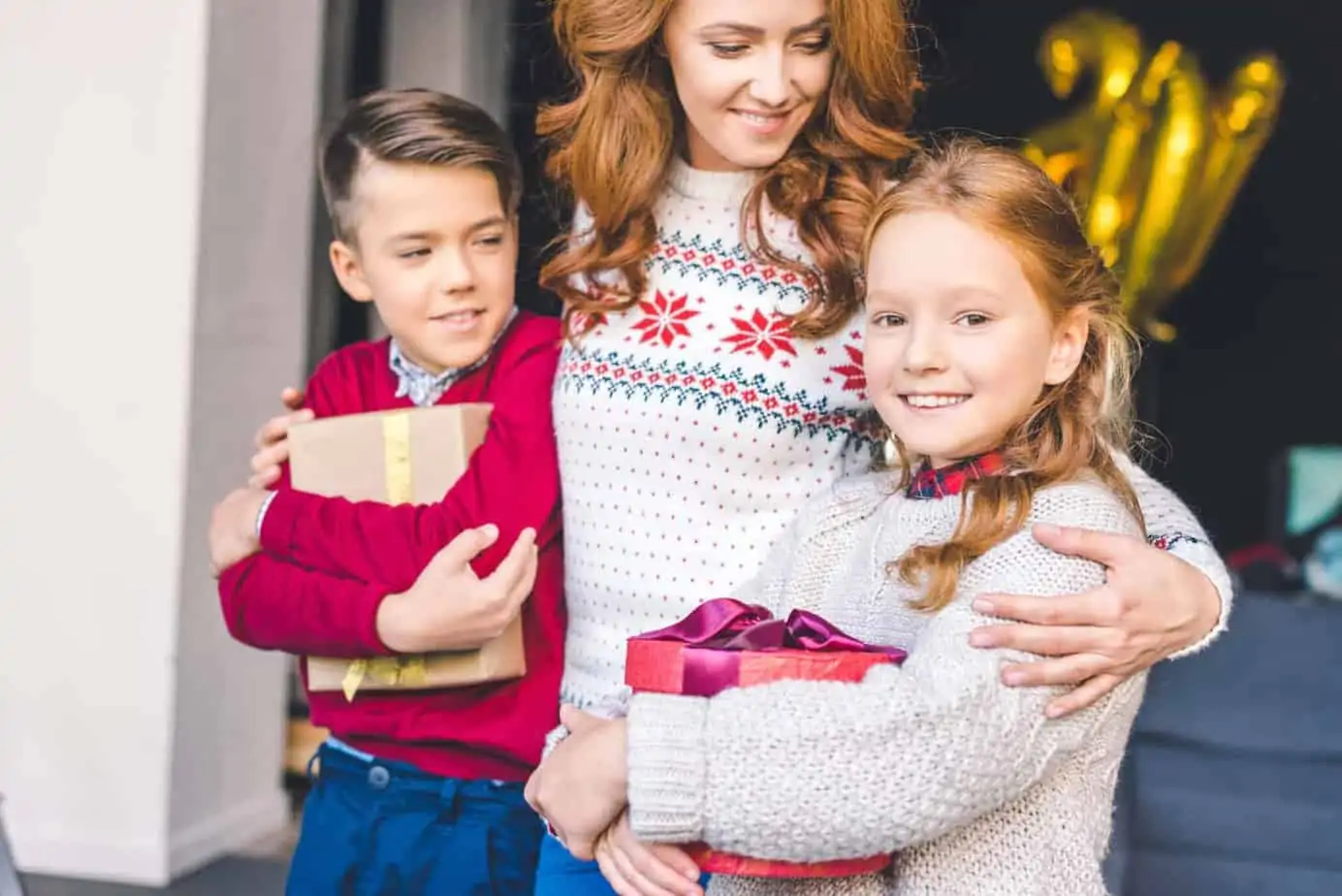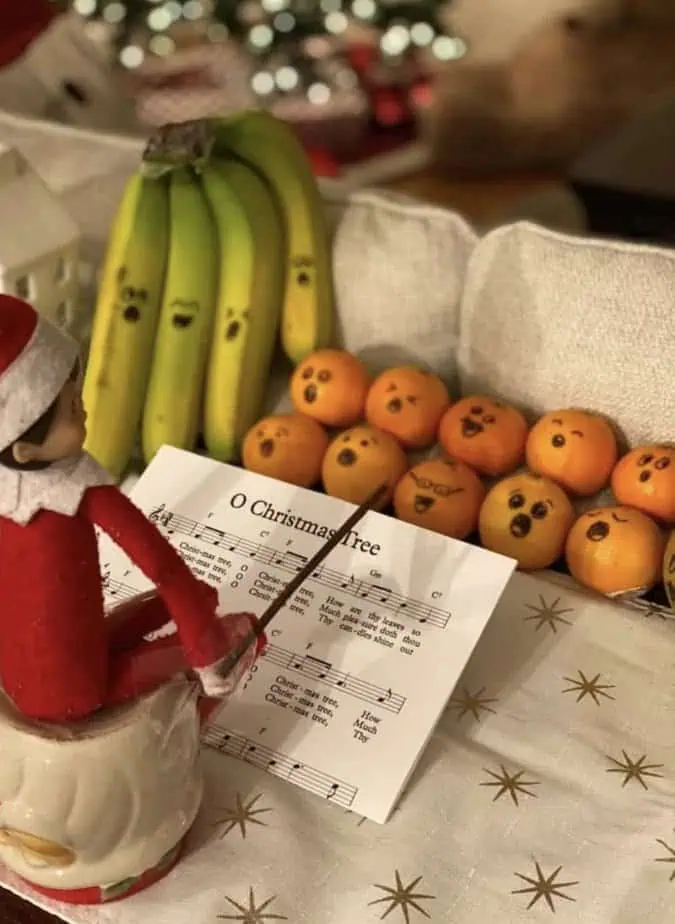Shifting from materialism to experiences, addressing kid’s expectations, and navigating the influence of commercialism while staying focused on the true spirit of togetherness and giving. How to cut back on gift giving and make the holidays meaningful without a mountain of presents.
Don’t forget to snag your Kid’s 99-Page Holiday Activity Kit, complete with Elf on the Shelf Notes & Letter Boards, Letter to Santa, Activity Sheets, Countdown to Christmas, Christmas Scavenger Hunts & I Spy Games, and much more!

Transforming the Holiday: Shifting from Gifts to Cherished Moments and Togetherness
The holiday season is a time of joy, love, and togetherness.
For many families, this is also a time of gift-giving and abundance. However, it’s also easy to get overwhelmed this time of year, compare your gift giving to others, overspend, over accumulate and have buyer’s remorse once the holiday season is over.
It’s essential for parents to learn how to strike a balance between generosity and instilling values such as gratitude and fiscal responsibility in their children.
Over the years, the spirit of giving can sometimes tip into excess, leading to concerns about entitlement and financial strain when no restraints are put into place.
As conscious parents, we want to not only find ways to recalibrate our approach to gift-giving during the holidays, without compromising the magic and happiness for our children, but of course, also be financially responsible.
Let’s explore practical strategies to navigate this delicate balance, helping you to ensure a meaningful holiday season for both children and parents.
Commercialism Plays It’s Role in Excessive Gift-Giving
Raise your hand if you agree commercialism significantly impacts holiday expectations, particularly regarding gift-giving.
The media, advertising, and consumer culture often portray an image of the holidays intertwined with lavish gifts and abundance.
Children can be easily influenced by this and especially when you have toy catalogues sent direct from retailers to your mailbox, it exposes a person to heightened expectations for lots and lots of shiny new presents.
Not to mention, peers in the classroom and playground can also stir up the desire to compare what one has to the other, and make a person both undervalue what they already have and then, want more, more, more.
Parents, on the other hand, grapple with the pressure to meet these expectations while being mindful of financial constraints and the impact of excessive consumption, both emotionally, mentally, and environmentally.
Balancing these factors can create a sense of conflict, where parents may fear that altering the gift-giving approach might disappoint their children and deviate from societal norms.
It’s crucial to recognize and manage these societal expectations while fostering a family culture that emphasizes the true spirit of the holidays—love, gratitude, togetherness, and giving back to your community.
Communicating openly with children about your family’s values and involving them in the decision-making process can help bridge the gap between commercial expectations and the desire for a more meaningful holiday experience.
Parents can incorporate gentle daily reminders during the holiday season that the true magic lies in the love a family shares, the time spent together is precious, and the joy of giving in various forms.
Shifting the focus from material gifts to heartfelt experiences and time well spent together can ultimately create a more enriching and fulfilling holiday season for both parents and children.
In This Article You’ll Find:
- 3 ways to reimagine gift giving so it’s geared towards more meaningful, financially responsible planning.
- Some behaviors and grumbles from kids you could see and a few carefully-crafted responses for parents, to keep in your back pocket.
Reimagining Gift-Giving: A Shift Towards More Meaning and a Financially Conscious Holiday and Less Materialism
To initiate a shift towards more mindful gift-giving, it’s essential to communicate openly and honestly with our children.
Start by setting the stage for this conversation. Gather your children and create a warm, open atmosphere. Explain to them that you want to make the holiday season more about togetherness, cherished moments, and the joy of giving rather than excessive material gifts.
1) Hold a Family Meeting to Talk About Expectations for the Holidays
Initiating an open dialogue with your children about shifting holiday gift-giving dynamics is a crucial first step. Choose a time when everyone can gather without distractions to discuss the upcoming holiday season. Begin by sharing your excitement for the holidays and how much you cherish the family traditions that make this time of year special.
Express that you’ve been reflecting on the true essence of the holidays and how you’d like to emphasize meaningful experiences and connections over material gifts.
Encourage each child to share what they love most about the holiday season, whether it’s the twinkling lights, the warmth of family gatherings, or the joy of giving and receiving gifts.
As they share, listen attentively and acknowledge their feelings and perspectives. Make it clear that their thoughts and opinions are valued. Once they’ve shared their thoughts, explain that you’re contemplating a shift in gift-giving towards experiences that will create lasting memories and foster stronger family bonds.
Invite your children to ask questions and share their concerns. Reassure them that this change is not about taking away from the magic of the holidays but about finding more meaningful and sustainable ways to celebrate.
Let them know that their input and ideas are vital in shaping this new approach to holiday traditions.
- Call To Order a Themed Family Gathering: Host a themed family gathering where everyone comes together to discuss the upcoming holiday season. Choose a theme like “Dream Holiday” where each family member can talk about their dream way to celebrate the holidays, encouraging creative and diverse ideas.
- Create Holiday Vision Boards: Provide materials like magazines, scissors, glue, and large boards. Ask each family member to create a holiday vision board, depicting what the holiday means to them. This can spark meaningful conversations about values and expectations.
- Storytelling Circle: Gather around a cozy fire or in a comfortable living room, and start a storytelling circle where each family member shares their favorite holiday memory and experience. This evokes nostalgia and reminds everyone of the joy of togetherness during the holidays and takes the focus off boxes under the tree.
2) Reimagining Gifts: Emphasizing Experiences and Togetherness Not Found Under a Tree
To guide your children towards valuing experiences over material possessions, delve deeper into the concept of experiential gifts. Highlight the joy and fulfillment that come from shared activities and adventures. Discuss the various experience-based gifts they could give, tailored to each family member’s preferences and hobbies.
For instance, suggest planning a family movie night with a film of the recipient’s choice, complete with popcorn and cozy blankets. Propose a nature outing with a picnic for the outdoorsy family member, or a cooking session for the culinary enthusiast. Encourage them to think about what each family member enjoys and create a list of experience-based gift ideas accordingly.
To solidify this shift, consider incorporating a new family tradition where each person gives and receives one experience-based gift. This can be accompanied by a heartfelt card expressing their love and excitement for the shared experience.
Reiterate that these gifts will create lasting memories, reminding them of the love and thoughtfulness that went into choosing them.
- Create a Family Experience Wish List: Set aside an evening for a “Family Experience Wish List” session. Provide each family member with a sheet of paper to jot down the experiences they’d like as gifts. Discuss and plan how to fulfill these wishes during the holiday season.
- Craft a Homemade Coupon Book: Encourage your children to create a coupon book with offerings like “One Movie Night of Your Choice,” “Family Hike Day,” or “Baking Extravaganza.” Family members can redeem these coupons throughout the holiday season.
- Do a Activity Planning Session: Hold a family meeting where you collaboratively plan holiday activities. Assign each family member a day to plan an activity, ensuring it aligns with the recipient’s interests. This promotes thoughtful planning and consideration for one another’s preferences.
3) Practicing Gratitude and Giving Back During the Holiday Season
Teaching children about the joy of giving back is a fundamental aspect of countering entitlement during the holidays. Discuss the idea that not everyone is as fortunate, and the holiday season is an opportunity to share our blessings with others.
Guide your children in selecting a cause or charity they are passionate about. Research together and find a cause aligned with their values, whether it’s supporting children in need, animals, or environmental conservation. Discuss how they can contribute a portion of their gift budget to this cause, emphasizing that this act of giving is a way to make a positive impact in the world.
Incorporate a family activity where everyone contributes to a community service project, like making care packages for the homeless or participating in a neighborhood cleanup. Here are some more family volunteering ideas.
Encourage them to reflect on these experiences and discuss how giving back made them feel, reinforcing the importance of empathy, kindness, and gratitude during the holiday season.
- Living in Gratitude: Begin or end each day during the holiday season with a “Gratitude Circle.” Each family member shares one thing they are grateful for. This cultivates a sense of thankfulness and appreciation.
- Support a Charity or Take a Charitable Shopping Trip: Organize a family trip to purchase gifts for a chosen charity or cause. Give each child a budget and let them select items to donate, teaching them the joy of giving to those less fortunate.
- Volunteer Together: Allocate a day during the holiday season for a family volunteering activity. Choose a local charity or organization and spend time together helping those in need. This hands-on experience will instill a sense of compassion and empathy.
Making a Change Might be Hard at First When the Expectation Has Always Been to Receive Plenty During the Holidays.
You Might See: Initial Disappointment or Confusion:
Children might initially feel disappointed or confused, especially if they are accustomed to a significant number of gifts.
Parent response: “I can understand this might be surprising. We’re making a change this year to focus on special experiences and meaningful gifts that we can enjoy together. It’s about creating lasting memories.”
When Kids Compare This Year to Previous Years:
Children may compare the current year’s gifts with previous years, noticing a difference.
Parent response: “I appreciate your observations. Let’s talk about how our traditions are evolving. We’ve decided to prioritize quality time and thoughtful experiences rather than focusing on the quantity of gifts.”
Try the Five (Now Six) Gift Rule for Christmas this year to help them streamline their wish lists and focus on what matters the most.
Kids Might Be Able to Politely Express Their Discontentment
Some children might express discontentment or unhappiness at receiving less or the changes you want to implement this holiday season, and that’s okay.
Parent response: “I understand you’re feeling a bit upset. Let’s discuss what the holidays mean to us as a family and why we’ve chosen this approach. It’s about valuing what truly matters and being mindful of our choices.”
The Weight of Peer or Social Influences
Children might be influenced by what their peers or society portray regarding the holidays and gift-giving.
Parent response: “I know it can be challenging when others have different traditions. Our family has unique ways of celebrating the holidays, focusing on love, togetherness, and giving in different ways.”
In Conclusion
Reimagining holiday traditions and recalibrating the spirit of giving is an empowering journey for both parents and children. By fostering open communication, prioritizing meaningful experiences, and embracing gratitude and giving, we can guide our children towards a more conscious approach to the holiday season.
Remember, the true magic of the holidays lies in the love, togetherness, and meaningful connections we share, not in the material abundance. Let’s make this holiday season one that enriches our family bonds and nurtures a sense of gratitude that lasts a lifetime.
Check Out All of Our Gift Guides:
- Ultimate Guide: 200+ Practical Non Toy Gifts for Kids That Aren’t Junk
- Best Board Games for Kids and Families to Play Together
- Best Gifts for Kids Who Love Arts and Crafts
- Best Outdoor Toys for Kids to Promote Active Play & Healthy Habits
- 40+ Unique Stocking Stuffers for Baby – Toddler (Ages 0 – 3)
- Non-Toy Gifts for Giving Children Experiences Not Things
- Gifts for Kids to Receive in the Mail All Year Round
Related Holiday Articles:
- 26 Unique Family Christmas Traditions To Make the Holidays Magical for Kids & Adults
- 26 Volunteer Opportunities For Kids This Holiday Season
- 52 of the Best Holiday Traditions You Must-Do this Christmas Season
- 6 Sibling Christmas Traditions: For Kids to Delight in the Excitement of the Holidays Together
- Family Fun Night: 20 Minute to Win it Games for Kids & Adults
Want even more?
Shop All Parenting Resources
Shop all of our parenting resources from self-regulation tools and managing big emotions to building self esteem and confidence. There are resources for all seasons of life!








